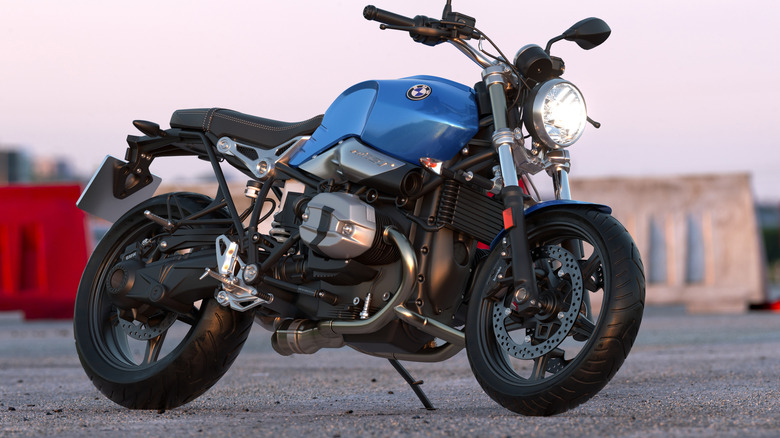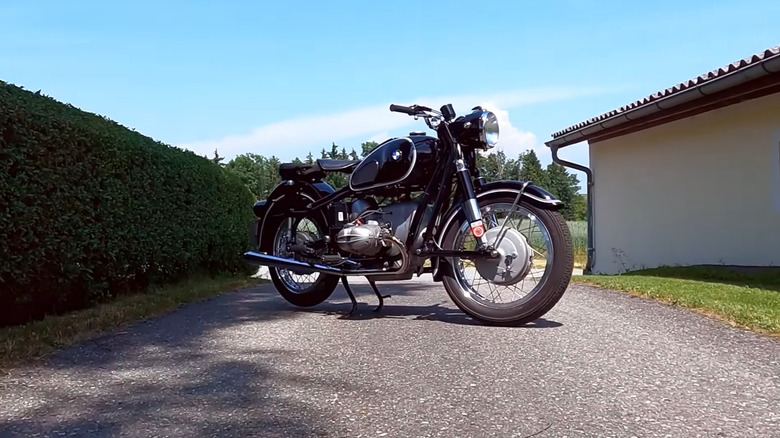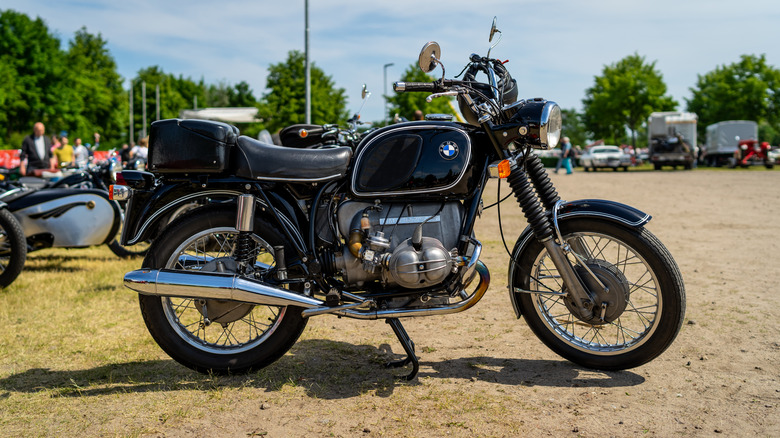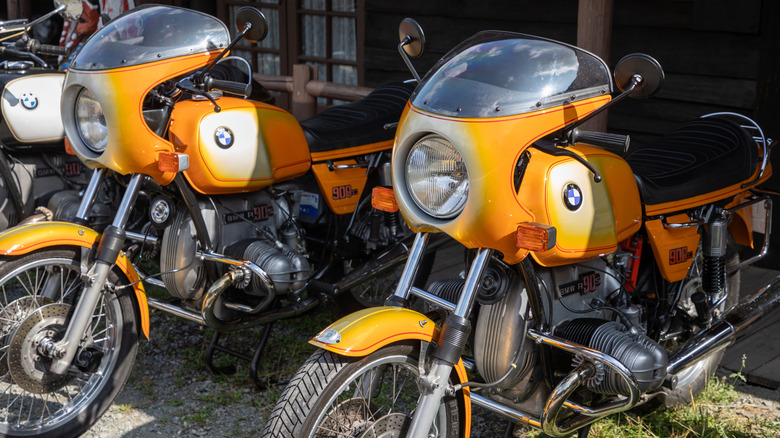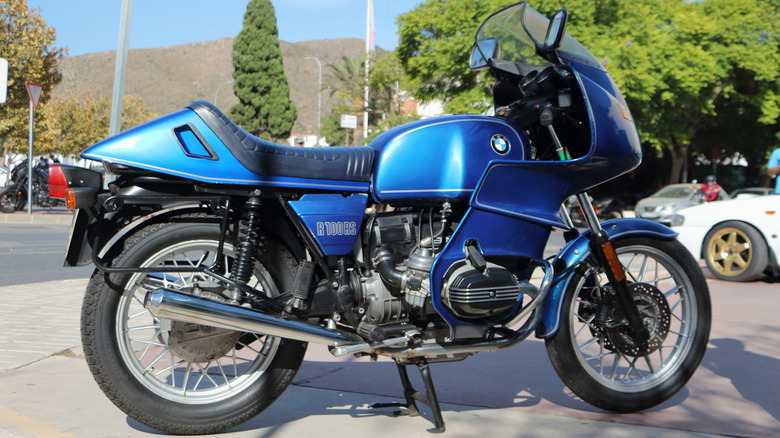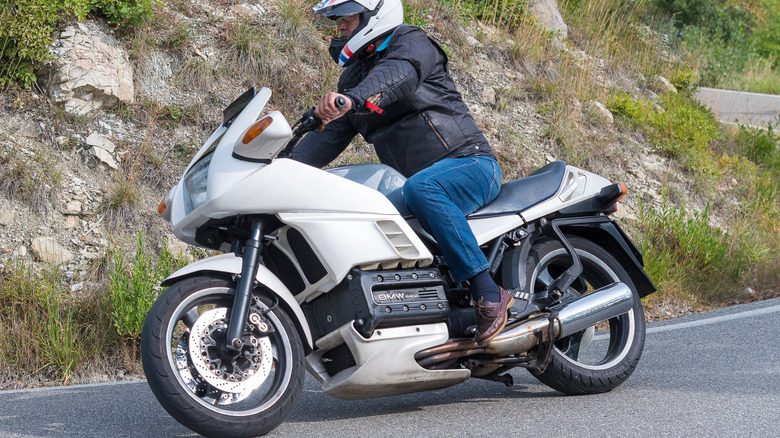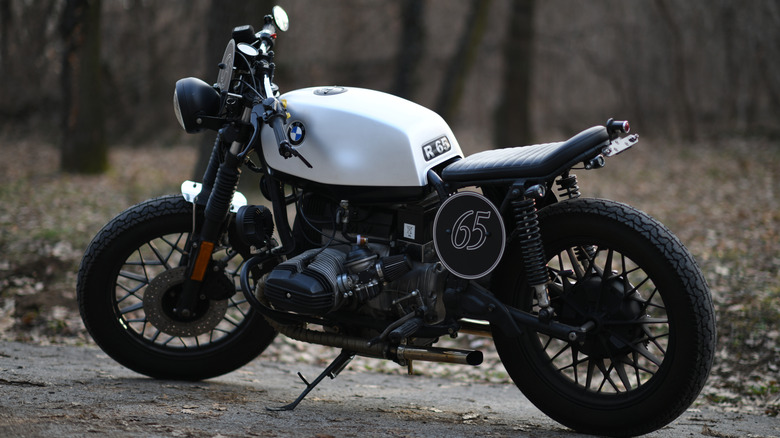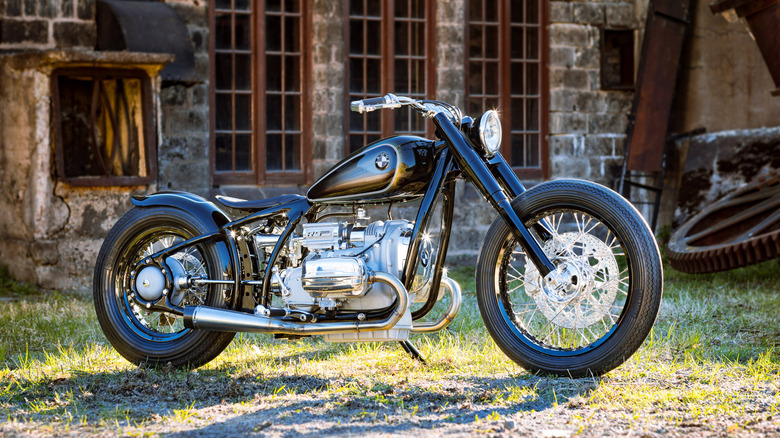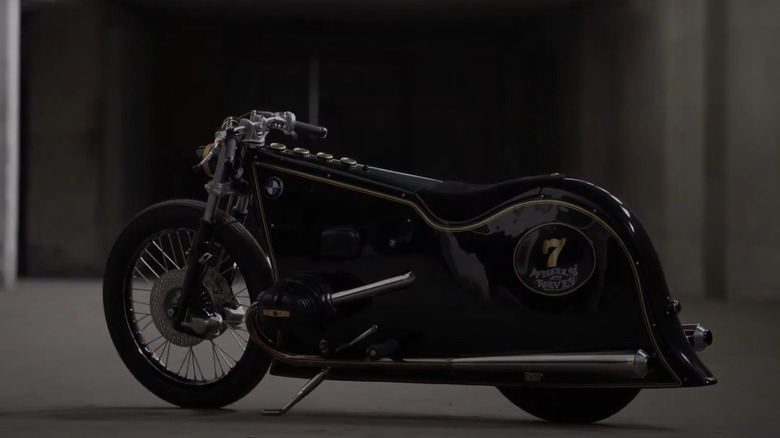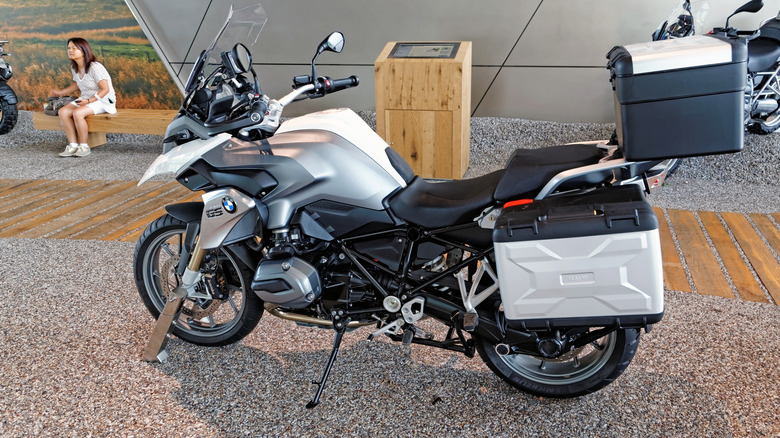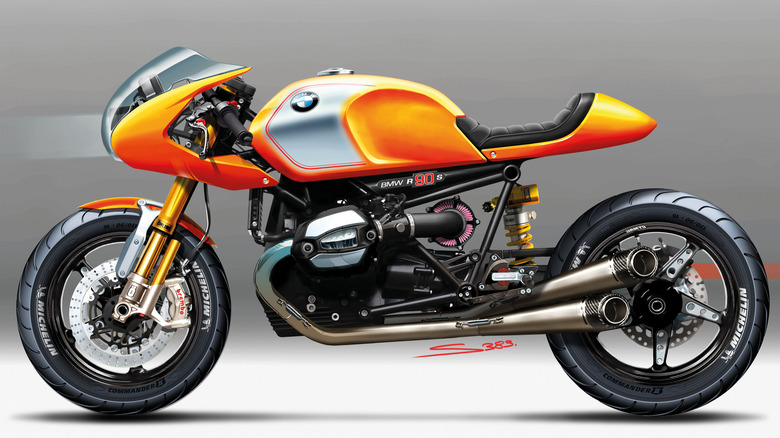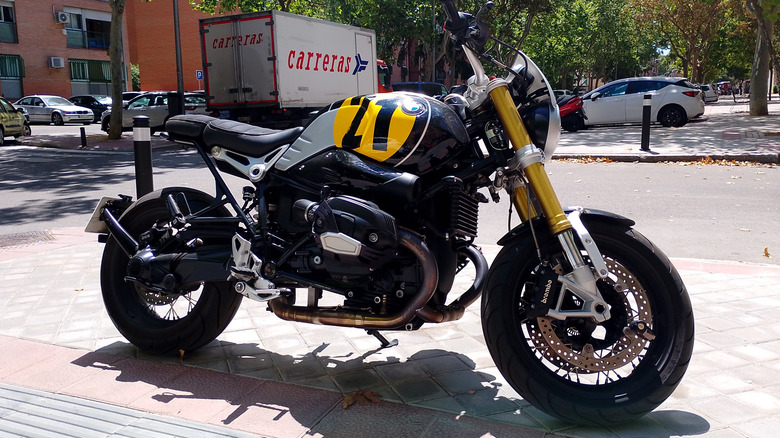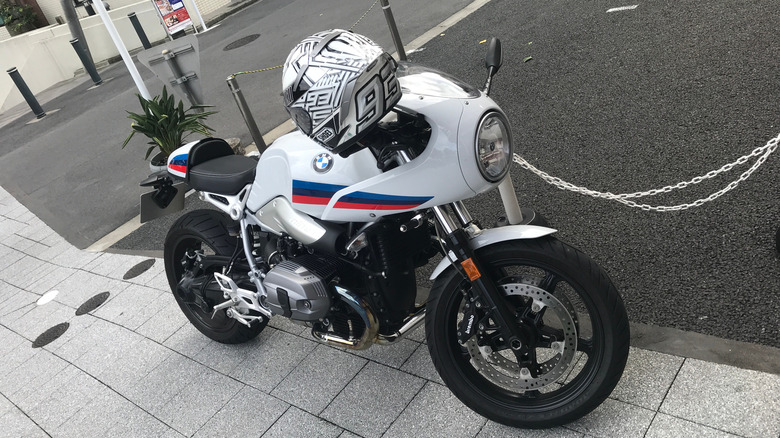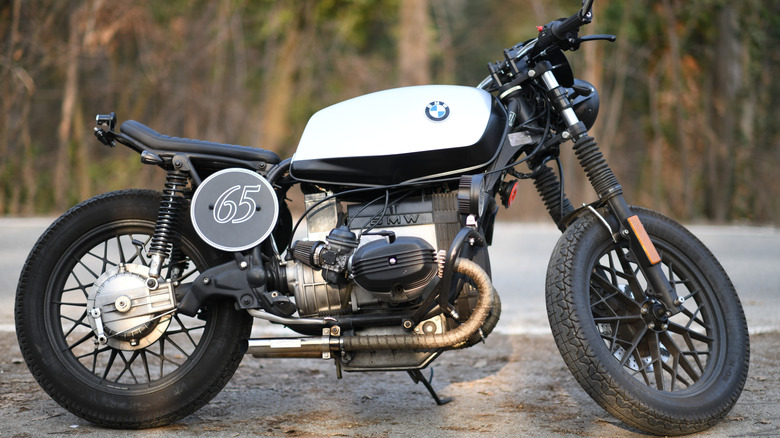13 Of The Best BMW Cafe Racers Of All Time
Many people have heard of the cafe racer. At the root of it, these were motorcycles that were supposed to look good and go really, really fast. It began in the U.K. when young motorcycle owners would modify their rides. Young riders discovered that they could easily squeeze more speed and performance out of their bikes with a few changes. For starters, the foot pegs were set further back, for a lower riding position that helped with stability and air resistance. The fuel tanks would often be smaller as well, as these bikes were built for short, fast trips, so range wasn't really a priority.
Many also added clip-on handlebars as well as other distinctive cosmetic modifications, and thus, some of the most iconic motorcycles of all time were born. Popular names in the scene were Triumph and Norton, though BMW joined the party later as well.
Classic early BMW motorcycles like the R-series gave riders both reliability and the beloved boxer engine. The boxer configuration, with its horizontally opposed cylinders, created a unique look and sound that resulted in some of the coolest BMW motorcycles of all time. These were among the fastest BMW bikes as well, which was an added plus. Here are 13 of the best BMWs to join the ranks of the cafe racer.
1960s R69S
First up, we have the BMW R69S, which joined the R60/2 in the BMW stable in the 1960s. It was a version of the already popular Touring R69, and came with a two-split seat and iconic white paint job. It also came with a 36.25 cubic inch (594 cc) power unit that produced 42 hp, which was approximately 20% more than the R68 that came before it, though the R69S only produced peak power at 7,000 RPM. It used a two-cylinder engine that had two carburetors to match, and as wet clutches hadn't really become standard yet (though the wet clutch was invented years prior), the R69S came with a dry clutch.
A key advantage that the R69S had over the U.K. competition was that, from 1963, the models came with a vibration damper on the crankshaft. As a result, the R69S would sit quite happily at its 109 mph (175 kmh) top speed for long stretches, while the competitors from across the pond may need the occasional break. Several factors contributed to this improved performance, including a rotary-disk ventilator (only S models), a more open exhaust, and a significantly larger air filter compared to previous models.
1969 R75/5
As the name suggests, the BMW R75/5 was an even more souped-up version of the already legendary R69S that we just covered above. It debuted in 1969, which was the same year that the R69S was phased out of production. However, the R75/5 would have a much shorter production run — half, in fact, of the R69S — at just 5 years, with manufacturing ceasing in 1973. The R75 was the introductory model in BMW's 5 range of bikes, which came with several upgrades. Chief among these included the addition of new telescopic forks at the front, a completely redesigned frame, and a much-improved engine.
Specifically, the biggest engine offered (there were three) was a 45.5 cubic inch (745 cc) boxer unit that had two cylinders, two carburetors from Bing, and a compression ratio of 9:0:1. This would come with a dry, one-plate clutch system and a shaft final drive that managed to output no less than 50 hp, the peak of which came about at 6,200 RPM, significantly better than the R69S. It was also quite torque-y, with 44 lb-ft available at 5,000 RPM. And then there were the looks of the thing – pure retro nostalgia wrapped in satin paint with lots of chrome, the perfect formula for cafe racer builds.
1970s R90S
The BMW R 90 S is one of the most successful BMW motorcycles of all time. It made its debut appearance in 1974 and had an eye-watering top speed of 123 mph. Stylistically, it was virtually unchanged from even the units from the early '60s, which were more than a decade old at launch. Production would continue till 1976, which is when major changes came into the lineup via the R100S replacement, but we'll chat about those further down.
At the time, the R 90 S came with a 55 cubic inch (898 cc) two-cylinder engine that was still air-cooled, though it had now switched to twin Dell'Orto carbs instead of Bing units. In terms of power, the engine made 67 hp at 7,000 RPM alongside 56 lb-ft of torque, all of which was available from as low as 5,500 RPM. This power would be sent to the wheel by way of a shaft final drive, which was still the standard for the era.
1970s R100RS
The R100 RS was one of the first cafe racers to carry the RS tag, though many would follow. In terms of top speed, multiple sources verify that this monster motorcycle would comfortably reach the 120 mph ballpark without much struggle. When launched, it came equipped with a radical new fairing and front end that was the first BMW bike to have been tested in a wind tunnel. All of that contributed to the fact that the R100 RS was indeed one of the best-looking and best-performing cafe racers ever to leave the factory.
Much of this performance can be attributed to the 60-cubic-inch (980 cc) boxer-twin powerplant that made 70 hp and 56 lb-ft of torque from 7,250 and 6,000 RPM, respectively. The compression ratio was approaching sportbike levels, at 9.5:1, and the twin carbs from Bing would have probably had to work overtime to provide the correct mixture to the thirsty bike. Still coming with a shaft final drive, the R100 RS was extremely performant, though, for those who wanted something even more hardcore, BMW would eventually release a GS Paris Dakardown the line.
1980s K100 Flying Brick
The Flying Brick is not a nickname that anyone would want their trusty iron stallion to have, but in the case of the BMW K100, it's not a bad thing. The nickname was given not for the aerodynamics, but based on the shape and size of the four-cylinder boxer engine, which was a significant step-up from the two cylinders that we've been seeing on this list so far. A displacement bump to 60.2 cubic inches (987 cc) alongside a doubling of the cylinder count and electronic fuel injection in lieu of carburetors meant that the performance was staggering.
The total output of 90 hp at 8,000 RPM alongside 62 lb-ft of torque at 8,250 RPM meant that the K100 had a brutal top speed of 132 mph, among the best at the time. An interesting fact about this engine is that it was very blatantly — er — inspired by the Peugeot 104 of all things. It was also one of the more comfortable bikes of the time, which, alongside the legendary boxer reliability, meant it made a great, frequent-use motorcycle.
The Flying Brick is also iconic because it was quite a departure from the blueprint at the time, coming with radical new stuff like fuel injection, industrial looks, and (further down the line on the sport version of the K100), the first anti-lock braking system (ABS) that BMW incorporated into a motorcycle.
1980s R65LS
The BMW R65 LS was first launched back in 1982. With a 40-cubic-inch (649 cc) two-cylinder engine, this air-cooled, four-valve unit actually punched well above its weight with twin Bing carbs and a shaft final drive. It produced 50 hp from 7,250 RPM, and 38 lb-ft of torque from a much lower 6,500 RPM. Respectable, but all of this was quite manageable and a far cry from the hulk and bulk of the R100s of the era.
This meant that the R65 LS slotted itself nicely into the gap between daily driver (rider?) commuter units and purely sport-oriented bikes. The R65LS would have been the perfect choice for anyone who was looking to get into the cafe touring scene without completely breaking the bank.
The design was also a departure from what BMW was running with at the time, with significant attention paid to a less-is-more philosophy — and it worked. The owners who specced their R65s with colors other than battleship grey and drab black would be rejoicing at the moment, as these things have aged beautifully.
2016 R5 Hommage
The R5 Hommage, as the name suggests, was a model that was intended to pay tribute to the legendary BMW R5 racer from the 1930s through the 1950s. It first made an appearance at what is arguably the most important automotive event after Monterey Car Week, the Lake Como Concours d'Elegance. The official name of the event is the Villa d'Este Concorso d'Eleganza, but regardless of what you want to call it, the R5 Hommage made a big splash at Lake Como. It is a fully custom ride, built to exacting standards, and production of the engine was outsourced to two brothers, Ronny and Benny Noren, who'd been making customs for three decades.
Readers would likely be very interested to learn that the top brass at BMW (at the time) were hands-on with the project, including the then head of heritage, Ola Stenegard, and the design boss, Edgar Heinrich. Power-wise, the 31-cubic-inch (500 cc) engine couldn't hold a candle to any of the other models we've looked at so far, but sometimes power is not everything.
2016 Deus Ex Machina Heinrich Maneuver
The Heinrich Maneuver was a custom bike made by Deus Ex Machina, who are known for outlandish and statement-making motorbikes. It is built upon the bones of the BMW R nineT, which also features further down on this list, and comes with several upgrades over the regular (if you can call it that) nineT. These include a bespoke seat trimming made from kangaroo leather, a fully handmade fuel tank reminiscent of 1960s cafe racers, custom badging on the fuel tank, and several other special bits and bobs around the bike.
While the engine is the same 71.4 cubic inch (1,170 cc) two-cylinder boxer unit as the nineT, the power figures have been given a slight bump of about 5%, as the Heinrich Maneuver produces six more hp at 110 versus the stock nineT's 104. There is perhaps no other motorbike that has been produced in recent years that manages to so cleanly replicate the old sport cafe racers of the '80s and '90s. We're calling it now: This thing, along with the regular nineT, is going to be a future collectible.
2017 Kingston Custom Black Phantom
Another one-off build that was made on the bones of an old BMW bike is the Black Phantom, made by Dirk Oehlerking. We say an old BMW bike, but it was actually several, being a Frankenstein project of sorts, with donor bits from a range of bikes, with the oldest being from 1951 and the youngest being from 1979. Enthusiast readers may know that the name is similar to another bike that came before it, called the White Phantom, and indeed, this is by design. The designer intended the Black Phantom to be a yin-yang counterpart to the iconic White Phantom that had dazzled onlookers a few years before.
The most unique bit about the Black Phantom is not its engine or a list of parts that reads like a garage inventory, but its appearance. With a full sheath hiding all internal parts on both sides, and bodywork that integrates the fenders, the Black Phantom really does make a statement. It is not understated in any respect, coming with gold embellishments on everything, where one would normally expect chrome to be. It is a polarizing design, but nothing embodies the cafe racing mentality of classic customization more than this unit, which is why it's on our list.
2008 BMW Lo Rider
The Lo Rider concept was presented to the public at the EICMA Milan auto show in '08, where audiences were immediately stunned by it. Hyper-naked looks, a superexposed engine, a forward-biased riding position, and extreme performance; this was a bike that, after a very long time, was clearly for the rider, and not for the commuter. The Lo Rider model had a 71 cubic inch (1,170 cc) flat-twin engine that was rated for over 100 hp.
The Lo Rider would have been one of those bikes where the only thing keeping you on the road would be extreme skill — they just don't make bikes this engaging anymore. Now, where the Lo Rider of 2008 never made it to production, future models did borrow very clearly from it, such as the F800R (pictured above) and R1200 series bikes of the early 2010s. It was close to a truly modern cafe racer, though the nineT did eventually meet that goal, albeit more than a decade later.
2013 Concept Ninety
The Concept Ninety, which debuted at the EICMA, is the prototype that kicked off the modern generation of BMW cafe racers and tourers. It is the parent model, so to speak, of the BMW nineT and its derivative units. It was made by Roland Sands Design to commemorate BMW Motorrad's anniversary, and was based on the looks of the R90S that we talked about earlier.
The eventual production variant of this bike would be called the nineT, which is also included further down. However, the reason we include the concept model, and the production nineT is that there was actually a world of difference between the two. The Concept Ninety was raw, untamed, and quite frankly, probably dangerous — but what motorcycle isn't?
The concept had a 55-cubic-inch (900 cc) twin-cylinder engine that was supposed to make over 115 hp, which would have been fantastic to have. Looks-wise, though, it nailed the vibe. With twin shorty exhausts, a single-rider seat, and a compact (and seemingly useless) wind fairing that would let you feel the wind on your face, the Concept Ninety was simply iconic. It's quite a pity that the (admittedly insane) modern production nineT watered down so many features in comparison.
2017 R nine-T standard
Introduced in 2016 as a derivative of the Concept Ninety, the R nineT quickly became a force in the modern motoring world. For the longest time, riders had been waiting for a true modern bike that could fit the cafe racer customization builds, and it seemed BMW had been listening. Debuting with a 71-cubic-inch (1,170 cc) boxer twin engine, the nineT made use of several innovative technologies like dynamic brake control, ABS, paralever suspension, and was EURO 5 compliant. This powerplant managed to put out a respectable 110 hp at 7,000 RPM and 88 lb-ft of torque at 6,000 RPM while weighing a (relatively) paltry 450 pounds.
In addition, the body work was, well, almost absent. A couple of panels here, a color-matched fuel tank with imperceptible badging, and a splash of chrome — and that was it. Everything on this bike was functional, right down to the impossibly thin and uncomfortable-looking seat for the rider — and that's how it should have been.
2017 BMW R nineT Racer
Finally, we have the ultimate modern BMW cafe racer bike, which comes to us in the form of the BMW R nineT Racer. BMW clearly had a resounding success with the standard R nineT from above. Many people were turning them into cafe racers, so BMW released a specific cafe-racer tribute edition called the Racer just a few short months later. Compared to the regular version, the Racer added all the bits and bobs that cafe racer modders would have done anyway, which included clip-on handlebars, rear-biased foot pegs, a humped seat that promoted a crouched-over riding position, and a conventional telescoping fork versus the inverted one on the standard nineT.
The brakes were also downgraded to Brembo caliper units as compared to the radial units (also from Brembo) on the standard nineT, putting the rider much more in touch with the road. All in all, this is the bike you should be looking to buy if you feel your stable is missing a cafe racer. It has all of the fun and none of the fallout of owning a heritage bike.
Methodology
When it comes to choosing the 'best' motorcycles of any type, it's always hard to be objective. However, we did try to be as thorough as possible when compiling this list by looking at which bikes impacted the cafe racer community. This could be through being extremely popular, or by setting off a trend, or by being the first to incorporate an innovative feature — basically, cafe racer Beemers that made their mark on history. For instance, the R90S was such a legend that it inspired the Concept Ninety, which in turn gave birth to the nineT and nineT Racer.
The Flying Brick K100 (and K1) were the first to come with ABS, and the R75/5 was the first radical departure from the bog-standard motorbike blueprint that all manufacturers were copy-pasting at the time. We hope you enjoyed this list of the best cafe racers from BMW, and you now depart with newfound knowledge to share at the next family brunch.
